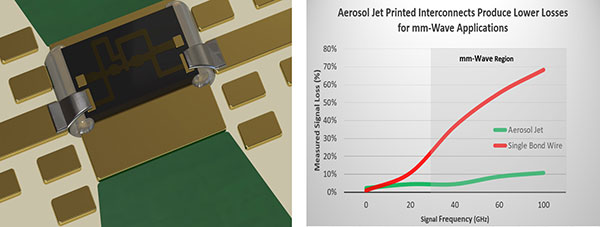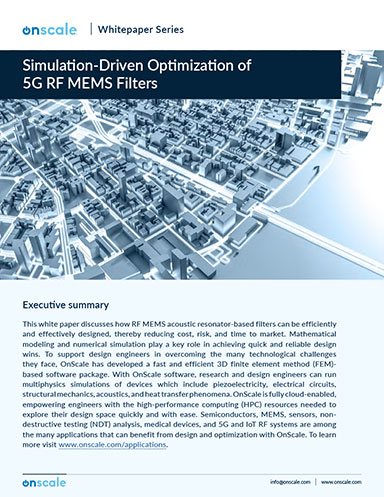
Illustration of aerosol jet printed interconnects (silver color) connecting to a mm-Wave component. Image courtesy of Business Wire.
Latest News
October 26, 2021
Optomec has introduced a new high-performance semiconductor packaging solution for the growing mm-wave electronics market, in response to demands from its customers in the 5G, Autonomous Vehicle, Defense and Medical segments.
Optomec’s 3D Printed Interconnect solution preserves device performance with low loss connections.
Optomec customers have reported up to a 100% increase in transmitted signal power for each circuit connection in the millimeter range. This translates to longer point-to-point range for wireless data transmission, reduced energy consumption and, because lower-power ICs can operate at lower temperatures, increased IC life, according to Optomec.
The millimeter-wave frequency band comprises 30 to 300 GHz. Whereas today’s typical wireless network in the home or office operates at 5 GHz, next generation wireless mm-wave networks will operate at frequencies up to 53 GHz; automotive radar, defense applications and medical imaging sensors operate at even higher frequencies. The older methods of connecting ICs, such as the use of tiny gold wires, is less and less effective as the frequency increases, but the Aerosol Jet method of printing the connection to ICs is reportedly much more efficient, with performance that nearly matches the etched copper traces of circuit boards, according to Optomec.
“Our customers are reporting some very impressive performance improvements for mm-Wave interconnects,” says Bryan Germann, Optomec product manager. “Customers across many industries using millimeter-wave frequency bands are seeing the benefits of printing interconnects in lieu of standard wire or ribbon bonds. The benefit of shorter, better impedance matched transitions lower losses for each die-to-die or die-to-board transition. This leads to improvements in overall device efficiency and performance.”
The Aerosol Jet process works by jetting extremely fine droplets of nanoparticle conductive inks onto circuit boards and components from a distance of up to 10 mm away, yet it can produce conductive features as fine as 10 microns in width. Optomec’s new Aerosol Jet HD2 printer with ultra-high printing resolution and integrated vision-based alignment has been optimized to support this new IC solution for full production applications. The HD2 supports standardized in-line automation for direct integration into existing packaging lines. Optomec further offers its customers pre-qualified printing recipes and application libraries for a total solution that is production ready.
Sources: Press materials received from the company and additional information gleaned from the company’s website.
More Optomec Coverage
Subscribe to our FREE magazine, FREE email newsletters or both!
Latest News
About the Author
DE’s editors contribute news and new product announcements to Digital Engineering.
Press releases may be sent to them via DE-Editors@digitaleng.news.






